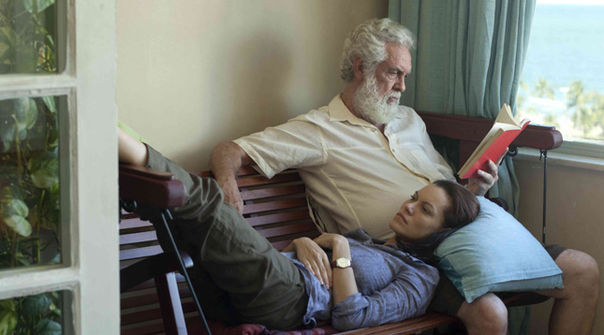The life and lives of Veronica
Lioman Lima Padrón of the 2013 Guadalajara Talent Press reviews Marcelo Gómes' poetic character drama ERA UMA VEZ EU, VERONICA.

Marcelo Gómes' film ERA UMA VEZ EU, VERONICA
ERA UMA VEZ EU, VERONICA is not (just) a film. It is a manifest about the research of identity, a sensual testimony, a gender study, an introspection of the human soul, as well as a picture of a generation and an epoch.
It is one of the few films in which each scene belongs, for an instant, to a succession of strophes. Strophes with verses of Sartre (whether accepted or not, existentialism is pure poetry), sensorial Greek rhymes of Safo and Kavafis, masks and identities from Pessoa… That is what this film is, a succession of verses in images; therefore, a poem.
As life is the main topic of poetry; life and the absence of life: death, life, death and its negation: sex (or love); life and love, death, sex, and its consequences: identity; the film of the Brazilian Marcelo Gómes is a journey to self discovery, a lyrical and critical transition from a character to adulthood.
Veronica (Hermila Guedes), is a 26 year old psychiatrist who just graduated and starts working at a decadent hospital in Recife (hometown of the film's director). She lives with her father (W.J. Solha) in an apartment at the beach; three reels after the beginning of the film, they will have to evacuate the house due to a problem with the structure of the building.
She listens to music, Karina Buhr mainly, lachrymose themes about emptiness. The father likes polkas and old frevos. Both turn these rhythms into another character, another sound mystery of the film.
Veronica has several lovers (at least it seems so) and she asks many questions, or maybe just one, or three. Questions which have no answer, questions whose answer won't be found either in last pages of the incomplete book of her life or in the books of discovery which are for her the bodies of her lovers.
She, as any of us, lives many lives, mainly two: the real one and the fantasy one (or should we say: her dream life).
These are the narrative levels of the film. First, Veronica in a public environment, as a doctor with her patients and conflicts, between professional and ethic debates. Sometimes the narrative level moves to her private life, at home, with her father and her lover.
With her father, she has a very intense affective fixation, very passionate, which is reminiscent of the myth of Electra. The relationship with her lover is more unfocussed, almost just suggested; this relationship is the source of one of her most important questions bound to an unnatural practice: the hard and painful task of fidelity.
Finally, we are privileged witnesses (voyeuristists?) of a psychoanalytic session which comprises the film. Veronica, as a narrator, uncovers her most private secrets to an audio recorder; she tries to understand herself.
Mauro Pinheiro's photography supports these perspectives; it moves and mixes interior close-ups at home and at the hospital with internal movements of the characters and almost documentary-style shots of the city or the carnival, as well as extremely intimate close-ups.
There is an extraordinary sequence when the father gets sick. Veronica takes him to the hospital. One of the doctors tells her the results; he confirms a very painful suspicion. As a doctor, veronica knows what he is going to say.
In that very moment of despair, there is a sequence in which Veronica goes from holding back her tears to desperate crying; a yell of existential anguish. Guedes confirms that her performance as an actress is the perfect image of what the film wants to express.
A cheeky halo of romanticism, an unreal paleness, a primitive aura, her sentimental exuberance and the look in her eyes meet together to confirm the crisis situations of the story needed to recreate the intimacy of that universe.
From that moment starts a disclosure of her intimate universe of elemental urges: joy, hidden pleasures, hedonism and adoration of ephemeral issues. For Veronica, this is a clue to understanding the conflicts of human existence.
Through her way of living, thinking and relating with others, through her sense of existence and role in the world, she represents the concept of an entire generation on life, pleasure and transition to maturity.
Distant from a moral speech, Gómes never questions the characters; he focuses on their point of view. Through his intent of recreating the lyricism of a woman's world, he reminds us of Bergman's WILD STRAWBERRIES. Contradictorily, he is even more poetic, less symbolic and less grouch.
The script is supported by a dramatic need of transformation of the lead character. It rescues the musical decadence of poetic cinema; the director confirms his mastery in the domain already seen in CINEMA, ASPIRINA E URUBUS (2005) or in VIAJO PORQUE PRECISO, VOLTO PORQUE TEA MO (2009), co-directed by Karim Ainuz (who must have been a great influence for the direction of Veronica).
Some may reproach this film due to its pauses and excessive lyricism; sometimes it may seem a psychoanalysis session through images. However, no one can deny thatERA UMA VEZ EU, VERONICA is as imperfect as it is deeply beautiful, as simple as complex and subtle.
Which is the most meaningful scene? The scene of great epiphany, the revelation before the last shot. An end which is also a beginning, still it is about a complete different character from the one of the start.
Around the 90th minute of the film, Veronica understands that she has to improve her internal world, her paradoxical spirituality, in order to bear her adult live and fate. This film defends the chance of dreams and the need of dreaming without boundaries. That is Veronica's personal revolution, her rebellion against idleness of common places, her victory against death fate, the everyday life and solitude - which should be our revolution as well.

